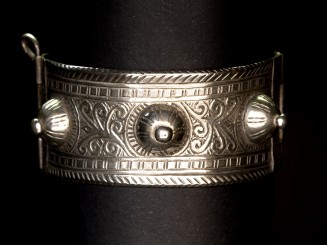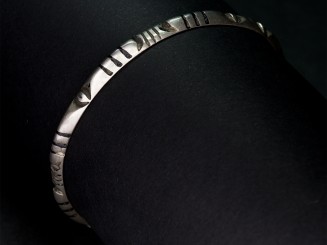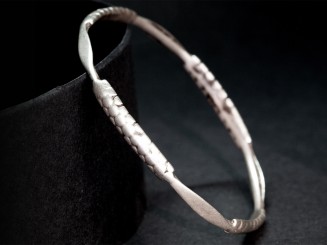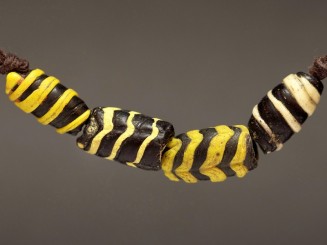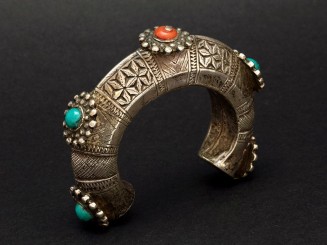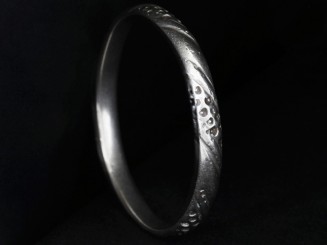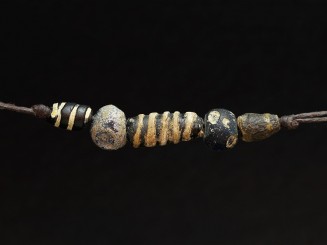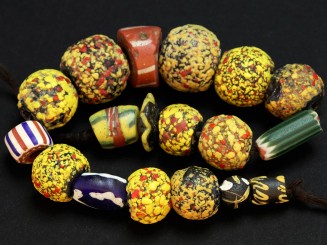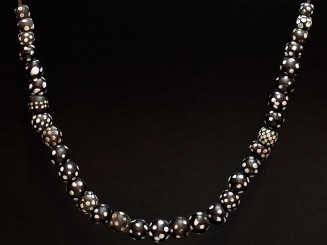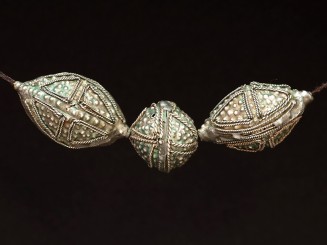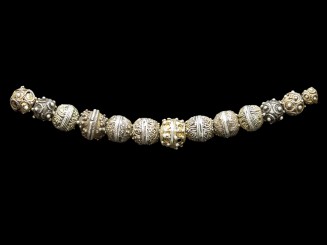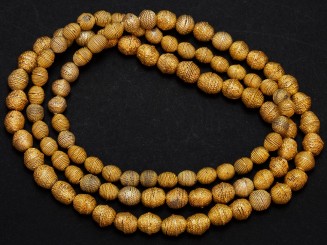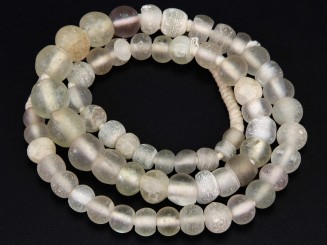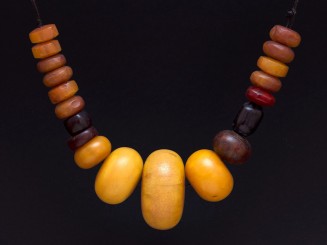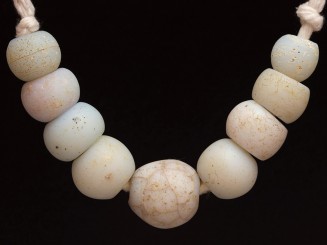
Jewels
-
-
Price €90.00MA1021-1091
A great old Moroccan silver bangle featuring the characteristic incised geometrical incised decoration and with some areas decorated in black and showing a wonderful silver granulation work. This kind of pieces a found mainly in Mauritania, Western Sahara and areas of Southern Morocco.
-
Price €56.00MA1021-1093
An old silver bangle featuring the characteristic geometrical incised decoration and with some areas in black . This kind of piece is mainly found in Mauritania, Western Sahara and areas of southern Morocco.
-
Price €84.00MA1021-1106
A beautiful pair of Berber silver bangles featuring a brilliant work of granulation. This kind of work is very characteristic of the deep south of Morocco (Goulimine), Mauritania and vast areas of Western Sahara.
-
Price €42.00MA1021-1100
A very attractive Berber old silver bracelet. It has lost part of its chiselled decoration due to intensive use but it has got a wonderful patina instead.
-
Price €160.00MA1021-1109
A superb set of seven old Moroccan Berber silver bangles ornated with incised decoration. In the origin it was a city piece of jewellery. One of its names was "simana" in reference to the seven days of the week. Other names: -slouk-, that is, -threads of iron-.
-
Price €220.00MA1021-511
A superb new silver Tuareg bracelet or -khulkhal- from Niger with an intricate and beautiful engraving work with protective designs for the wearer. Other names: -kholkhal-, -khalkhal-, -khelkhal-, -natal-. Adjustable.
-
Price €110.00MA1021-1085
A very attractive Berber old silver bracelet. It has lost part of its chiselled decoration due to intensive use but it has got a wonderful patina instead.
-
Price €68.00MA1021-1088
A very attractive Berber old silver bracelet. It has lost part of its chiselled decoration due to intensive use but it has got a wonderful patina instead.
-
Price €210.00MA1021-1082
A nice Berber molded and chiselled silver bracelet from Morocco. This is a design that originated in an urban environment -citadine- in North Morocco and then spread to other areas such as Rif, Jbala and further to Southern Morocco. Other names: -taasir saboun-. Mid- XXth century.
-
Price €290.00MA1021-1081
A nice Berber molded and chiselled silver bracelet from Morocco. This is a design that originated in an urban environment -citadine- in North Morocco and then spread to other areas such as Rif, Jbala and further to Southern Morocco. Other names: -taasir saboun-. Mid- XXth century.
-
Price €36.00MD0316-320
A great set of four ancient Islamic lampwork glass beads featuring a great spiral/feather pattern high relief decoration in a captivating yellow and whitish colors on a great black core. Full of character and showing a great patina considering their age.
The larger bead is approximately 15mm (long) by 9mm (diameter).
When referring to Islamic beads we follow bead expert Robert K. Liu’s description in Ornament Magazine: “The term Islamic Period Glass Beads is used, similarly to Roman Period Beads, to classify groups of ornaments from specific geographic areas and time periods, with recognizable characteristics including patterns and techniques. In the case of Islamic glass beads we know they originated in the Middle East and flourished mostly between the seventh and twelfth centuries. Their designs display a wide mix of techniques and styles: millefiori/mosaic (including pierced mosaic pad beads), trailed, filigreed, combed, fused rods, segmented/blown, folded (an Islamic innovation, Holland and Holland 2006) and those derived from amulet shapes, like charmcase beads with loops.” Islamic glass beads travelled from their sources of production in the Middle and Near East together with the expansion of Islam to North Africa, Southern Europe (Spain), India and the Far East and they reached areas well beyond Islam’s actual limits of expansion such as Northern Europe. They also flowed into Sub-Saharan Africa, where they were valued and cherished for centuries in the Malian ancient kingdoms as a symbol of status and played an important role in the communities’ rites and ceremonies such a burials, initiation or dowries.
Lamp working is one of the main techniques for the making of glass beads. Lamp or lamp work beads were made using glass canes that were reheated to a temperature of up to 1000 ºC by means of a blowtorch or blowlamp and which were then wound onto a coated iron rod to avoid the molten glass from sticking to the metal. The beads produced by the artisan by these means could be then further decorated by re-heating the bead using the same lamp work method and applying colored glass rods or glass cane inserts to the surface of the bead creating an endless variation of patterns and making of each bead one of its own.
-
Price €270.00PK1205-055
An exquisite old silver, red coral and turquoise bracelet. It features a wonderful chiselled and engraved decoration and most appealing rosettes ornated with coral and turquoise cabochons. Its design takes us to the pashtoon tribes in Northern Pakistan and Afghanistan. The quality of the chiselling, engraving and granulation on this piece is outstanding, elegant and well-balanced. First half of the XXth century.
-
Price €110.00MA0220-243
A very attractive Berber old silver bracelet. It has lost part of its chiselled decoration due to intensive use but it has got a wonderful patina instead.
-
Price €105.00MA0220-248
A great old Moroccan Berber silver bracelet from the Occidental Anti-Atlas. Beautiful incised decoration and very nice patina.
-
Price €110.00MA0220-245
A very attractive Berber old silver bracelet. It has lost part of its chiselled decoration due to intensive use but it has got a wonderful patina instead.
-
Price €119.00MA1018-420
A Berber silver and enamel bracelet from the city of Tiznit in South Morocco. Ornated with blue, green and yellow enamel. Very good quality of work. Adjustable size.
-
Price €32.00MA1117-032
An old silver bangle featuring the characteristic geometrical incised decoration and with some areas in black and red. This kind of piece is mainly found in Mauritania, Western Sahara and areas of southern Morocco.
-
Price €32.00MA1117-031
A very attractive Berber old silver bracelet. It has lost part of its chiselled decoration due to intensive use but it has got a wonderful patina instead.
-
Price €25.00MA1117-045
A cute old Moroccan Berber silver bangle ornated with incised decoration. In the origin it was a city piece of jewellery. As a part of a seven bangle set they were known as "simana" in reference to the seven days of the week. Other names: -slouk-, that is, -threads of iron-.
-
Price €29.00MA1117-047
A cute old Moroccan Berber silver bangle ornated with incised decoration. In the origin it was a city piece of jewellery. As a part of a seven bangle set they were known as "simana" in reference to the seven days of the week. Other names: -slouk-, that is, -threads of iron-.
-
Price €15.00BC1215-660
Five authentic ancient beads from the Islamic Period (8th to 12th centuries). Three of them showing spiral motif and the other two are eye beads. Marvelous patina after centuries of being buried, including iridescence on one of them.
The central bead measures 20mm long and 8mm in diameter.
When referring to Islamic beads we follow bead expert Robert K. Liu’s description in Ornament Magazine: “The term Islamic Period Glass Beads is used, similarly to Roman Period Beads, to classify groups of ornaments from specific geographic areas and time periods, with recognizable characteristics including patterns and techniques. In the case of Islamic glass beads we know they originated in the Middle East and flourished mostly between the seventh and twelfth centuries. Their designs display a wide mix of techniques and styles: millefiori/mosaic (including pierced mo-saic pad beads), trailed, filigreed, combed, fused rods, segmented/blown, folded (an Islamic inno-vation, Holland and Holland 2006) and those derived from amulet shapes, like charmcase beads with loops.” Islamic glass beads travelled from their sources of production in the Middle and Near East together with the expansion of Islam to North Africa, Southern Europe (Spain), India and the Far East and they reached areas well beyond Islam’s actual limits of expansion such as Northern Europe. They also flowed into Sub-Saharan Africa, where they were valued and cherished for centuries in the Malian ancient kingdoms as a symbol of status and played an important role in the communities’ rites and ceremonies such a burials, initiation or dowries.
-
Price €39.00BC1215-659
A lovely set of eight old translucent glass faceted monochrome beads and a blue oval islamic one. The first would have been produced in the eighteenth century in the city of Amsterdam in order to imitate rock crystal and other precious stones in the trade with the African and American colonies. The red bead with white nucleus could be Venetian. The blue oval one is much older, quite similar beads have been found in fortresses of the Bizantine period in Albania. Beautiful range of colors.
Central oval bead measures 16x11x7mm.
The Dutch beadmaking industry seems to have a short but intense history. Since the SXVI, large quantities of glass beads were produced in the city of Amsterdam thanks to the incorporation of Venetian beadmakers who brought in the necessary techniques and tools to supply Dutch merchants in the incipient trade with the colonies in Africa, Asia and the New World.
We use the term trade beads to refer to the European made glass beads that were used by the European merchants and explorers in the trade in Africa as from the 15th century and continued during their colonial expansion.
The history of trade beads in Africa takes us then to the 15th century and the arrival of the European, mainly the Portuguese, to the coasts of West Africa. The European discovered quite soon how much the people they met there fancied beads and saw they an opportunity for trade. Amongst the beads that captivated the African people most were glass beads since the techniques for their making had not yet been developed locally. The locals fell for the precious and colorful glass beads such as Venetian millefiori or chevron beads that the European traders had on offer and bartered them for commodities such as precious woods, ivory, gold and even used, ignominiously, in the slave trade. The increasing demand in Africa of European made glass beads continued quite until the first half of the 20th century and it had a boosting effect in the production in cities such as Venice which glass beads became very popular and coveted.
-
Price €65.00BC1215-658
A lovely selection of eighteen mixed Venetian trade beads. Circa late 18th to early 20th centuries. Highlights three chevrons and ten “end of the day” beads.
Central bead measures 14mm in diameter
The so called “End of the Day” beads, as the story goes, would be made at the end of the working day by the artisans using the leftovers of other beads made during that day. The result is as pop and modern as you can see.
European glass chevron trade beads were certainly the first to be traded in Africa as early as the 15th century. They show a very characteristic “Rosetta” or “star” layered decoration attained by giving form to glass in a star shaped moulds. Layer after layer are applied to form a cane, which is then cut into cylinders and ground to show the alternated chevron or star layers. They were first produced in the Venetian island of Murano at the Barovier glass factory. The rarest examples are very much coveted and they are quite commonly tagged by the number of layers they show.
We use the term trade beads to refer to the European made glass beads that were used by the European merchants and explorers in the trade in Africa as from the 15th century and continued during their colonial expansion. The history of trade beads in Africa takes us then to the 15th century and the arrival of the European, mainly the Portuguese, to the coasts of West Africa. The European discovered quite soon how much the people they met there fancied beads and saw they an opportunity for trade. Amongst the beads that captivated the African people most were glass beads since the techniques for their making had not yet been developed locally. The locals fell for the precious and colorful glass beads such as Venetian millefiori or chevron beads that the European traders had on offer and bartered them for commodities such as precious woods, ivory, gold and even used, ignominiously, in the slave trade. The increasing demand in Africa of European made glass beads continued quite until the first half of the 20th century and it had a boosting effect in the production in cities such as Venice which glass beads became very popular and coveted.
-
Price €95.00BC1215-657
The model of these thirty-three beautiful Venetian trade beads is without any doubt among those most popular in barter trade in West Africa. They were made at artisan workshops in Venice from the mid-1800s to the first third of the 19th century using the lamp work technique. The very typical eye or dotted decoration classes them as eye beads. The combination of white dots on a black background, though there are other combination of colors, made them known in the trade as “black and white skunk” as they reminded of the fur of this animal. In Spain they where also known as “Moorish” beads and where sometimes found as part of the jewellery arrangements of traditional “charra” jewellery from the province of Salamanca.
The larger bead measures approximately 12mm (long) and 14 mm (diameter).
We use the term trade beads to refer to the European made glass beads that were used by the European merchants and explorers in the trade in Africa as from the 15th century and continued during their colonial expansion. The history of trade beads in Africa takes us then to the 15th century and the arrival of the European, mainly the Portuguese, to the coasts of West Africa. The European discovered quite soon how much the people they met there fancied beads and saw they an opportunity for trade. Amongst the beads that captivated the African people most were glass beads since the techniques for their making had not yet been developed locally. The locals fell for the precious and colorful glass beads such as Venetian millefiori or chevron beads that the European traders had on offer and bartered them for commodities such as precious woods, ivory, gold and even used, ignominiously, in the slave trade. The increasing demand in Africa of European made glass beads continued quite until the first half of the 20th century and it had a boosting effect in the production in cities such as Venice which glass beads became very popular and coveted.
Eye glass beads are beads which main feature are circular decorations that remind of an eye made using lamp work, inset or mosaic techniques. One of the best examples of eye beads are found among Islamic beads mostly blue or green with white eyes as well as eye dotted Venetian glass beads (skunk). The eye decoration may be a simple eye or a number of them scattered on the surface of the bead, they may be plain ones or concentric ones using different colors. Eye beads may also present some linear trails, ziz-zag or floral decoration. Eye beads have been very much valued for centuries, actually they still are, among not only Islamic people but also African people as they were regarded as strong amulets to avert the evil eye and for their alleged prophylactic and magical properties.
Lamp working is one of the main techniques for the making of glass beads. Lamp or lamp work beads were made using glass canes that were reheated to a temperature of up to 1000 ºC by means of a blowtorch or blowlamp and which were then wound onto a coated iron rod to avoid the molten glass from sticking to the metal. The beads produced by the artisan by these means could be then further decorated by re-heating the bead using the same lamp work method and applying colored glass rods or glass cane inserts to the surface of the bead creating an endless variation of patterns and making of each bead one of its own.
-
Price €85.00BC0417-051
Three truly awesome, beautiful and sought after old Mauritanian silver beads (agrabb al-fadda). These beads are hollow and made by welding very thin martelé silver plaques. In this case they also feature a lovely filigree silver lace decoration. Early 20th century.
Central bead measures 17mm in diameter and lateral beads lenght is 28mm.
-
Price €90.00BC0417-049
Thirteen outstanding silver old beads with traces of gilding bath. Featuring an intricate work of granulation and filigree very characteristic of Mauritanians goldsmiths. Very rare to find especially in good condition. Beautiful patina. Beginning of the 20th century or earlier.
Larger bead measures 9mm in diameter and the smallest 5mm.
-
Price €270.00BC0417-048
A Very original set of one hundred and two vintage gilding bath silver beads from the skillful hands of a Mauritanian artisan. Uniques!
Avarage diametre between 5 and 7mm
-
Price €39.00BC0417-047
Three superb vintage biconic gilding bath silver beads from Mauritania. Made by lace filigree. Very original!
Average measures 22mm long by 8mm diameter.
-
Price €66.00BC0417-046
Four beautiful vintage bi-conical tabular gilding bath silver beads featuring granulated filigree work decoration. Very original!
Average size 23x11x6mm
-
Price €350.00BC0417-043
Superb gilding bath silver beads necklace. It features the characteristic and intricate granulated and filigree decoration of the Mauritanian goldsmiths. Second half of the 20th century.
Central bead measures 17mm in diameter and the smallest 7mm.
-
Price €135.00BC0417-041
A superb strand of Dutch glass trade beads popularly called "moon beads" due to the beautiful opalescent reflection they produce to the light. They were among the trade beads produced in the Netherlands in the 18th century and were widely popular among the Dogons in Mali and also in Ethiopia.
The Dutch beadmaking industry seems to have a short but intense history. Since the SXVI, large quantities of glass beads were produced in the city of Amsterdam thanks to the incorporation of Venetian beadmakers who brought in the necessary techniques and tools to supply Dutch merchants in the incipient trade with the colonies in Africa, Asia and the New World.
We use the term trade beads to refer to the European made glass beads that were used by the European merchants and explorers in the trade in Africa as from the 15th century and continued during their colonial expansion.
The history of trade beads in Africa takes us then to the 15th century and the arrival of the European, mainly the Portuguese, to the coasts of West Africa. The European discovered quite soon how much the people they met there fancied beads and saw they an opportunity for trade. Amongst the beads that captivated the African people most were glass beads since the techniques for their making had not yet been developed locally. The locals fell for the precious and colorful glass beads such as Venetian millefiori or chevron beads that the European traders had on offer and bartered them for commodities such as precious woods, ivory, gold and even used, ignominiously, in the slave trade. The increasing demand in Africa of European made glass beads continued quite until the first half of the 20th century and it had a boosting effect in the production in cities such as Venice which glass beads became very popular and coveted.
-
Price €105.00BC0417-040
A very original Mauritanian vintage and old glass, stone and resin beads necklace. Mauritania’s fascination for beads has in this colorful necklace a good example. Venice and Bohemia glass trade beads, outstanding the four small Chevrons. Four beautiful rhomboidal “African amber” resin larger beads, and the triangular central pendant, a most probably Czech imitation in glass of the Idar-Oberstain carnelians.
The triangular central pendant measures 26x27mm
-
Price €149.00BC0417-035
Superb set of 19 phenolic resin beads, bakelite or Catalin, commonly known as "faux amber" or "African amber". They were very popular in the 20s and 30s until the arrival of World War II cut down its production and partly because of that today they are so scarce and appreciated. In Northern and Western Africa they were used as a substitute for amber or Copal in their traditional necklaces. Nice range of ocher and red colors. Notice the twelve hand faceted disk beads.
The large central bead measures 47mm in diameter and 26mm in width. The red disk measures 19x9mm.
-
Price €45.00BC0417-032
A precious set of nine opaque white glass trade beads made in The Netherlands in the 17th century. Popularly known as “Dutch Dogon” due to the fact that this Malian tribe highly used them and would consider them as fertility amulets because of their egg shape. (Dogon eggs)
The central bead measures 24x24mm
These antique wound glass trade beads are commonly known as Dutch Dogon. The reason for that is that they were first made in The Netherlands and it would become extremely popular among the Dogon people in Mali. They are quite large in size and the are usually found in bkue color though they were also made in white, black and brown. The first ones known date as back as the XVIIth century. Very attractive and eye-catching.
The Dutch beadmaking industry seems to have a short but intense history. Since the SXVI, large quantities of glass beads were produced in the city of Amsterdam thanks to the incorporation of Venetian beadmakers who brought in the necessary techniques and tools to supply Dutch merchants in the incipient trade with the colonies in Africa, Asia and the New World.
We use the term trade beads to refer to the European made glass beads that were used by the European merchants and explorers in the trade in Africa as from the 15th century and continued during their colonial expansion.
The history of trade beads in Africa takes us then to the 15th century and the arrival of the European, mainly the Portuguese, to the coasts of West Africa. The European discovered quite soon how much the people they met there fancied beads and saw they an opportunity for trade. Amongst the beads that captivated the African people most were glass beads since the techniques for their making had not yet been developed locally. The locals fell for the precious and colorful glass beads such as Venetian millefiori or chevron beads that the European traders had on offer and bartered them for commodities such as precious woods, ivory, gold and even used, ignominiously, in the slave trade. The increasing demand in Africa of European made glass beads continued quite until the first half of the 20th century and it had a boosting effect in the production in cities such as Venice which glass beads became very popular and coveted.
-
Price €75.00BC0417-031
This is a great set of fourteen antique Islamic glass eye lamp work beads sourced in Mali in the region south of the Niger river between the cities of Mopti and Gao. Though they have been buried for hundreds of years they show a nice condition and a wonderful patina and iridescence. Theire colors range from different shades of blue from dark blue (almost black) to aquamarine. Some of them show some band decoration which adds to their appeal.
The dimensions range from a diameter of 15 mm for the larger bead to 11mm for the smaller one.
When referring to Islamic beads we follow bead expert Robert K. Liu’s description in Ornament Magazine: “The term Islamic Period Glass Beads is used, similarly to Roman Period Beads, to classify groups of ornaments from specific geographic areas and time periods, with recognizable characteristics including patterns and techniques. In the case of Islamic glass beads we know they originated in the Middle East and flourished mostly between the seventh and twelfth centuries. Their designs display a wide mix of techniques and styles: millefiori/mosaic (including pierced mosaic pad beads), trailed, filigreed, combed, fused rods, segmented/blown, folded (an Islamic innovation, Holland and Holland 2006) and those derived from amulet shapes, like charmcase beads with loops.” Islamic glass beads travelled from their sources of production in the Middle and Near East together with the expansion of Islam to North Africa, Southern Europe (Spain), India and the Far East and they reached areas well beyond Islam’s actual limits of expansion such as Northern Europe. They also flowed into Sub-Saharan Africa, where they were valued and cherished for centuries in the Malian ancient kingdoms as a symbol of status and played an important role in the communities’ rites and ceremonies such a burials, initiation or dowries.
Eye glass beads are beads which main feature are circular decorations that remind of an eye made using lamp work, inset or mosaic techniques. One of the best examples of eye beads are found among Islamic beads mostly blue or green with white eyes as well as eye dotted Venetian glass beads (skunk). The eye decoration may be a simple eye or a number of them scattered on the surface of the bead, they may be plain ones or concentric ones using different colors. Eye beads may also present some linear trails, ziz-zag or floral decoration. Eye beads have been very much valued for centuries, actually they still are, among not only Islamic people but also African people as they were regarded as strong amulets to avert the evil eye and for their alleged prophylactic and magical properties.


